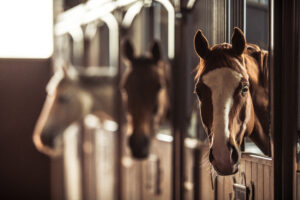Understanding Horse Aggression
Get to the root cause of aggression and pursue appropriate training to help keep horses and humans safe

The 7-year-old Warmblood was a show jumping superstar—or at least, he used to be, back when riders could get on him. The 17-hand horse became so dangerous his owners were losing hope. That’s when they sent him to the Australian equitation-science-based horse trainer Andy Booth, now based in Chamadelle, France.
“You couldn’t even get him out of the stall without getting kicked,” Booth recalls. The stallion threatened anyone who approached the door. If you managed to get a lead on him, he’d rear to vertical, striking out incessantly toward the handler. In the rare event handlers could get him saddled, he’d buck and twist to throw the rider high and far.
We’ve asked experts to find out why horses display aggression and how to manage them—whether the label is accurate or not—for the safety and welfare of both species.
Normal Aggression in Horses
Horses showing aggression toward other horses—but not other species—are likely just displaying their normal species-specific behavior, says Christine Aurich, DVM, PhD, head of the Graf Lehndorff Institute for Equine Science, in Neustadt, Germany.
Still, domestic horses usually limit aggression to nonviolent threats, says Alice Ruet, PhD, welfare science engineer at the French Institute of the Horse and Equitation (IFCE), in Saumur, France. If you provide enough space—whether in the field or under saddle—horses generally work out aggressive encounters via body language.
“Being highly aggressive is probably not biologically adaptive, as horses would waste energy fighting when they could be resolving issues through subtle behaviors instead,” explains Janne Winther Christensen, PhD, associate professor in the Department of Animal and Veterinary Sciences at Aarhus University, in Tjele, Denmark.
Horse Aggression Toward People
Today’s domestic horses reflect five millenia of selective breeding to avoid aggression. In fact, tamability was likely the first trait people targeted when domesticating horses around 3000 B.C., says Ludovic Orlando, PhD, director at the Center for Anthropobiology and Genomics of Toulouse, in France.
His team recently noted a rapid generational drop in the presence of ZFPM1—a gene associated with aggression—in ancient bones at horses’ earliest domestication sites, in Kazakhstan. That drop occurred well before breeding for height, muscle mass, speed, or rideability. “One way to start the animal domestication process is to have the behavior under control,” Orlando says
This story requires a subscription to The Horse magazine.
Current magazine subscribers can click here to and continue reading.
Subscribe now and gain unlimited access to premium content.
Subscribe NowWe at The Horse work to provide you with the latest and most reliable news and information on equine health, care, management, and welfare through our magazine and TheHorse.com. Our explanatory journalism provides an understandable resource on important and sometimes complex health issues. Your subscription will help The Horse continue to offer this vital resource to horse owners of all breeds, disciplines, and experience levels.

Related Articles
Stay on top of the most recent Horse Health news with


















